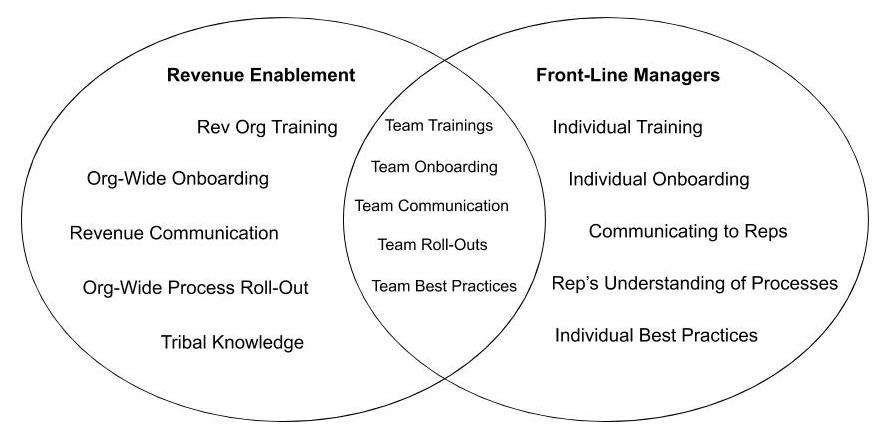Stop Putting Out Fires—4 Tips to Become More Proactive and Strategic Enablement Org
WorkRamp Contributor
Learning Tips Straight to Your Inbox
Guest post by Jonas Taylor, Revenue Enablement Manager at Algolia.
Hyper-growth is insane. The double-triple-triple-double philosophy sounds like the crazy strategy of an obsessive baseball coach. And indeed, it’s a hefty feat for any early-stage sales organization. But this “growth at all costs” mentality often blinds us to what matters most: people and process.
B2B Sales attrition rates are almost three times higher than the average attrition rate for all roles. How can we counter this trend? Research has proven that effective sales enablement programs can decrease both attrition, and time to full productivity. To break down the simple math, good processes produce — and support — good salespeople.
Creating sustainable, repeatable sales success is the foundation for any GTM strategy, so it’s no surprise that companies like Salesforce, RingCentral, Docusign, and Yext have all prioritized enablement initiatives during their early years.
In this post:
Becoming a Strategic Revenue Partner
The Algolia Enablement program is rapidly scaling, but we’ve had difficulty establishing ourselves as a strategic partner to Revenue. Our organization originally viewed Enablement as a reactive, triage-type of supporting function, simply putting out fires with no method to the madness. As we evolve today, we’re faced with the challenge of redefining ourselves as a data-driven, proactive team that effectively manages revenue-generating programs.
In this post, I’m going to share our initial approach to handling these internal challenges in four steps:
- Make Company Priorities Your Priorities
- Build Partnerships with Your Front-Line Managers
- Identify Pains Before they Become “Infected”
- Establish Feedback Loops
It’s important to use all four of these steps at once, as they complement each other and keep the proactive Enablement life cycle sustainable!

Making Company Priorities Your Priorities
As our team shifts from a reactive to a proactive state, it’s easy to get bogged down by all the things we need to get done. Discerning what is a “nice-to-have” versus a “need-to-have” is a great starting point, but it doesn’t answer the why behind what we’re doing. We need to go further upstream.
Enablement programs shouldn’t be seen as checklists of random items, but more like pieces to a puzzle. In other words, the puzzle piece is the what, the placement of the piece is the how, and the finished puzzle is the why.
Since our company uses OKRs to align on company goals and objectives, we’re at an advantage when it comes to declaring the why behind our programs. Having a clear objective, especially when it’s aligned with a business priority, makes it easier to create actionable and measurable programs.
Aligning our team’s objectives with company goals has helped us focus our efforts on what matters most, but there’s still a lot to be done. To begin with, every project partner believes their project is the most important, so how do we prioritize and delegate within our team?
Enablement programs shouldn’t be seen as checklists of random items, but more like pieces to a puzzle. In other words, the puzzle piece is the what, the placement is the how, and the finished puzzle is the why.
We’ve found ourselves utilizing the Eisenhower Matrix to avoid “peanut-buttering.” Putting a framework in place is essential to finding the balance between importance and urgency. When you’re doing this on the micro-level to support macro-level company OKRs, you’ll find that your Enablement team will be less stressed, less confused, and more focused. Plus, you’ll save yourself a lot of peanut butter.
Building Partnerships with Your Front-Line Managers
Internally, we refer to Front-Line Managers as FLMs. If you don’t know how to work with FLMs, they can easily make you say “FML.”
We actually share a lot in common with Front-Line Managers. FLMs enable their direct reports, while we enable the revenue organization. If you were to picture a Venn diagram, the overlap between the organization and the individual would occur on the team-level.

Traditionally, overlap between roles highlights an inefficiency of some sort. But in this case, it’s an opportunity for a partnership because both of our KPIs are aligned towards attainment (i.e., Managers wanting Individual Attainment vs. Enablement wanting Org-Wide Attainment).
Since Enablement has such a massive scope, it’s essential that we lean on managers when doing our job. And vice versa: it’s a lot of responsibility to manage a person, so it’s vital that managers lean on Enablement to help support their teams.
The simplest way to start this partnership is to ensure that your rhetoric aligns with your team’s mission. Your language creates your reality. If you work for a mature Enablement org, try to avoid using terms like triage, reactive, cleanup, or support. Instead, use terms like preventative, optimize, strategic, and proactive.
The next step is to tactically approach managers with a repeatable, scalable method for communicating with your partners. Internally, we’ve found ourselves practicing effective communication skills like active listening, asking the right questions, and utilizing data in our conversations.
Finally, we’ve mapped out our meeting cadences and relationships between each Enablement team member and the managers they work with. This helps prevent duplication of efforts, and highlights communication gaps on our end. For example, if we’re collectively spending more time with one or two teams, we might need to shift our focus or delegate to another team member to ensure that all teams receive an equal amount of attention and support. Here’s your chance to spread all that leftover peanut butter.
Finding Pain Before it Becomes Infected
The snowball effect is real. That’s why Enablement teams, especially those that sit closer to Sales or Business Operations in their org structure, have the unique opportunity to advise on front-line pains and challenges relating to overarching business goals.
For humans, pain and inflammation are essential to our biological survival, as they indicate that something’s wrong. If it weren’t for inflammation or pain, you wouldn’t know about your cold or that spider bite on your thumb. Waiting too long for treatment while the problem festers can be detrimental, increasing your risk for infection.
For Revenue orgs, pain is an inescapable part of the scaling process. There shouldn’t be any stigma around it. However, if pain goes unaddressed or it’s addressed in the wrong way, the problem can easily snowball past the point of no return — the same way an untreated infection will spread.
Since Enablement works with so many different types of teams, acquiring multiple perspectives on the same problem, we have a really unique point of view to offer. We’re firmly rooted in an understanding of company priorities, and can share valuable insights we’ve gathered from the front-lines.
For revenue orgs, pain is an inescapable part of the scaling process. There shouldn’t be any stigma around it.
When offering advice or recommendations to stakeholders, it’s essential to do two things:
- Provide data that matters
- Make sure to provide a tactical action plan
Data interpretation, both qualitative and quantitative, is an essential skill in an Enablement professional’s tool belt. However, when sharing your insights, make sure to be more solution-focused than problem-focused. While everyone’s going to want to know the root cause of why a particular pain or problem is occurring, it’s easy to find yourself slipping down a rabbit hole with a bunch of vanity metrics, but no understanding of the actionable metrics to solve the problem at hand.
Providing a tactical action plan is the second phase, and most important part, of preventing “infections.” Being proactive is more than providing a diagnosis: it’s all about the prescription.
For Enablement, this is the moment we go back to steps 1 and 2: Company Priorities and FLMs. Make sure your proposed solution shares commonalities with overarching company goals, and utilize your partnerships with front-line managers to ensure that change is widely adopted and implemented.
Creating Feedback Loops
And last but not least: establish feedback loops! Depending on the maturity of your Enablement team, you may not need an over-sophisticated dashboard that tells you everything, but you do need to establish a culture of sharing and transparency where ICs and LCs can share their honest feedback with you on trainings and programs. Otherwise, how will you iterate and improve?

At Algolia, we’ve established various feedback channels through NPS surveys, quarterly enablement reviews with managers, and one-off conversations with reps. These conversations often confirm the current Enablement priorities (determined by company quarterly goals), but they can also create a constructive commentary which inspires new projects, or highlights a new challenge that should be elevated and addressed on the leadership level.
Identifying the Right Approach for Your Organization
There’s no magic formula for doing Enablement the right way, but we can all agree that a proactive Enablement team brings much more value to an organization than an Enablement team that is narrowly focused on reactive troubleshooting.
That’s not to say drop what you’re doing and provide a tactical action plan to cure every tiny infection in your organization right this moment. Each company has a different stage, with different needs. But establishing your team as strategic, proactive partners will help you become more efficient, hew closer to the business, and work more effectively as an Enablement organization.
______

Jonas Taylor is a member of the Global Revenue Enablement Team at Algolia, a Search-as-a-Service platform transforming digital experiences for companies like WeWork, Intuit, Salesforce, and Zendesk. In this guest post, Jonas uncovers 4 tips that have helped Algolia transform their Enablement Organization from a crisis response team to a forward-thinking, strategic partner to the Revenue team.
Algolia, listed in Wealthfront’s 2021 list of Career-Launching Companies, is currently hiring for a number of roles in Revenue. They’re also looking for an experienced Technical Enablement Pro! If you’re interested in joining the Revenue Enablement Team at Algolia, reach out to lish@algolia.com!
Complete the form for a custom demo.
Recent Posts
- Top LMS Integrations That Power Smarter, Faster Learning July 2, 2025
- Introducing WorkRamp Analytics Studio: Unlocking Your Data Insights with AI June 30, 2025
- 11 AI LMS for AI-Powered Learning June 27, 2025
- The Best LMS Platforms for Customer Retention (2025 Guide) June 27, 2025
- 11 Best AI Learning Platforms June 16, 2025
WorkRamp Contributor
You might also like
Your Company Needs A Unified Training Platform
WorkRamp is the leading unified training platform for customers like Slack and Zoom. Train internal employees and customers using one system.
Read More
Lish Gates on Strategies for Scaling Enablement and Being Customer-Centric
Learn how to scale enablement, run a successful SKO, and build a global function from one of the best enablement leaders in the industry.
Read More
How to use blended learning for corporate training
A blended learning environment combines multiple approaches, including self-paced, collaborative, trainer-support, or traditional classroom teaching. Discover how to use blended learning to empower your workforce.
Read More
Ready to Get Started?
Get in touch to learn how WorkRamp can help you achieve your training goals.
Request a Demo




